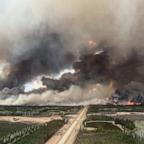Transcript: Pilots joked, talked shop before Buffalo-area crash
WASHINGTON -- In the minutes before their commuter plane gyrated out of control near Buffalo, the pilots of a Continental Connection flight joked and talked about work conditions — distractions that were forbidden under federal law.
The cockpit recording released by the National Transportation Safety Board Tuesday offers some of the first clues that could help explain why the pilots allowed the plane to get too slow and then apparently tugged the plane into a sudden, fatal climb.
It shows that the pilots were perhaps inattentive during a critical phase of the flight as they prepared to land. Other evidence released by the safety board suggests they may also have suffered from lack of sleep, poor training and inattentive oversight by federal regulators.
Capt. Marvin Renslow, 47, urged copilot Rebecca Shaw, 24, who had complained that she was not feeling well, to pop her ears seven minutes before the crash.
"Yeah, I wanta make 'em pop," she replied, laughing, according to the transcript of the sounds in the cockpit. Federal aviation regulations forbid any non-work related conversation during an approach to landing.
Neither pilot realized that they had reduced the power to a dangerously low setting, according to the recording and other data released by the safety board. The plane lost 57 mph in less than 30 seconds, slowing well below the airline's required minimum speed of 166 mph during icing conditions.
What happened next doomed the flight. The plane's "stick shaker" — a device that warns pilots when a plane gets too slow — activated, violently vibrating the control column.
Instead of adding power and lowering the plane's nose as pilots are taught, Renslow pulled the plane into a climb that slowed it even further.
"Jesus Christ," he said.
As Renslow struggled with the controls, Shaw tried to help by resetting flaps on the plane's wings and retracting the landing gear.
"Gear up, oh (expletive)," she said.
By this time, the plane's wings were no longer keeping the plane aloft — known as an aerodynamic stall — and it was rolling violently from side to side and plunging toward the ground.




